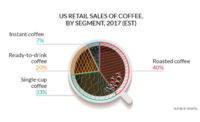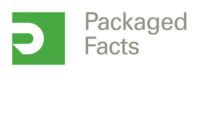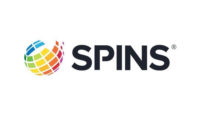US Non-Dairy Milk Sales Reach $2.11 billion
Steady growth over the past five years has led to a 61% leap in sales

As the popularity of plant-based nutrition grows, it seems non-dairy milk* is increasingly finding its place in Americans’ refrigerators. New research from Mintel reveals that non-dairy milk sales have seen steady growth over the past five years, growing an impressive 61% since 2012, and are estimated to reach $2.11 billion in 2017.
While almond (64% market share), soy (13% market share) and coconut (12% market share) remain staples in the category, new non-dairy milk types are sparking excitement as consumers look to diversify their non-dairy milk repertoire. Indeed, new varieties have experienced fast growth in popularity as two thirds (63%) of those who have purchased pecan milk say they bought more pecan milk in 2017 than in 2016, while 58% of quinoa milk consumers say they bought more quinoa milk in 2017 than the year prior.
“While almond, coconut and soy milks remain the most popular types of non-dairy milk, other nut and plant bases are gaining traction, including pecan, quinoa, hazelnut and flax milks. Both established and new brands are taking advantage of the growing non-dairy milk segment, innovating with alternative non-dairy bases. Innovation will be a catalyst to drive the category forward in 2018 as both mainstream bases like almond and alternative plant bases offer added functional benefits and unique flavors. We predict that new plant bases such as cashew and rice will allow new entrants into the non-dairy milk category to eventually surpass the soy milk segment, one of the first non-dairy milk segments to really take off with consumers,” said Megan Hambleton, Beverage Analyst at Mintel.
As flavor innovation catches consumers’ eyes, Mintel research shows that flavored milk is the fastest growing segment of the dairy milk category over the last five years, with sales estimated to reach $1.74 billion in 2017, an 18% increase since 2012. And it seems there will be no slowing down in years to come as sales of flavored milk are forecast to continue to grow 21% by 2022. Behind this sales growth is an increase in interest from consumers for their favorite flavors as two in five (40%) dairy milk consumers** agree that they bought more flavored cow’s milk in 2017 than in 2016. What’s more, one in 10 (11%) dairy/non-dairy milk consumers*** agree they are buying more milk because of the innovative flavors.
Despite sales making a splash, flavored dairy milk has room to grow as just one quarter (23%) of Americans say they have purchased flavored cow’s milk such as chocolate****. While children under age 18 are more likely (78%) to drink flavored milk, it seems adults are pouring themselves a glass as well, with more than three quarters (76%) of adult flavored milk buyers saying they drink flavored milk.
Another segment gaining momentum is whole milk as sales have increased eight% since 2012 and are estimated to reach $5.36 billion in 2017. As many consumers move toward a more natural and holistic approach to nutrition, skim/low-fat dairy milk sales have decreased 28% in the last five years and shelf stable dairy milk sales have decreased nine%. Overall sales in the dairy milk category have fallen 15% since 2012, reaching an estimated $16.12 billion in 2017.
“As the dairy milk category increasingly faces cross-category competition, flavor will play a growing role in determining where consumer dollars go. Appealing to kids and adults, flavored milk is one of the only milk types that lends itself to multiple occasions such as being consumed on its own as a thirst quencher, accompanying a meal or as a post-workout recovery drink. With the increase in flavor options, as well as innovations that promise better nutrition, flavored milk will be a segment that helps fill the gap left by skim and low-fat milk options,” continued Hambleton. “We’re also seeing whole-fat options thrive in the dairy milk category as consumer preferences shift in favor of full-fat, whole milk products that appeal due to taste, nutritional content and are viewed as beneficial for both children and adults.”
When it comes to purchasing milk, dairy and non-dairy consumers take different approaches. While nearly all non-dairy milk consumers also purchase dairy milk (90%), they tend to consider more factors when purchasing. Non-dairy milk purchasers are more likely to seek out milks that deliver on flavor (48% vs 40% of dairy consumers), vitamins and minerals (43% vs 36% of dairy consumers) and that are high in protein (42% vs 31% of dairy consumers). Non-dairy milk buyers are also more likely to look for ingredients that are natural (46% vs 36% of dairy consumers) and/or organic (33% vs 23% of dairy consumers).
It seems consumers do not put dairy and non-dairy milk on the same shelf when it comes to perceptions about health. In fact, the types of milk (including dairy and non-dairy) that Americans perceive to be the healthiest are whole cow’s milk (20%), skim/low-fat cow’s milk (18%) and almond milk (17%). Despite this, however, nearly one in five (19%) Americans say they are consuming less dairy for health reasons.
“The healthy positioning and messaging leveraged by non-dairy brands has made an impression on consumers who purchase both dairy and non-dairy milk. Dairy milk often delivers on many of the attributes non-dairy milk consumers are looking for, but there is a clear lack of understanding. This indicates that dairy brands must better communicate the natural health benefits of dairy milk through campaigns or packaging claims. By focusing on some of the influential factors that non-dairy milk consumers want when looking for milk, such as flavor and health benefits, dairy milk brands may see more success retaining consumers within the category,” concluded Hambleton.
* Non-dairy milk includes both refrigerated and shelf-stable ready-to-drink almond milk, coconut milk, soy milk and other refrigerated milk substitutes.
** US internet users 18+ who have purchased dairy milk in the three months to July 2017.
*** US internet users aged 18+ who have purchased non-dairy milk in the three months to July 2017.
**** In the three months leading to July 2017.
Looking for a reprint of this article?
From high-res PDFs to custom plaques, order your copy today!





